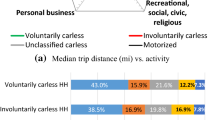Abstract
The number of short trips by car is increasing. The objective of this paper is to look at why people use their cars for such trips. The paper draws upon the results of surveys carried out as part of a project for the Department of the Environment, Transport and the Regions (DETR) to investigate the potential for switching short car trips to other modes in Great Britain. The paper commences by considering the various approaches used to look at why people travel by car and, from these, concludes that there is a need to examine the behaviour underlying specific real trips by car. This is followed by a description of the survey methodology used in the project which forms the core of this paper. Then the evidence on why people used their cars for a set of real short trips identified in the surveys is presented. This is considered in terms of a number of dimensions including age, sex, and trip purpose. This is followed by a discussion of the alternatives to the car that drivers say that they might adopt and the factors which they say would make them consider switching to these alternatives.
Similar content being viewed by others
References
Ajzen I (1985) From intentions to actions: A theory of planned behaviour. In: Kuhl J & Beckmann (eds) Action-Control: From Cognition to Behaviour. Heidelberg: Springer.
Ben-Akiva M & Lerman SR (1985) Discrete Choice Analysis: Theory and Application to Travel Demand. Cambridge, Mass: The MIT Press.
Black CS (1997) Behavioural Dimensions of the Transport Sustainability Problem. Ph.D. Thesis, Departments of Geography and Civil Engineering, University of Portsmouth.
Bradshaw R (1995) Why do parents drive their children to school? Traffic Engineering and Control 36: 16–19.
Burnett P & Hanson S (1982) The analysis of travel as an example of complex human behaviour in spatially-constrained situations: definition and measurement issues. Transportation Research A 16A: 87–102.
Cervero R (1996) Mixed land uses and commuting: evidence from the American housing survey. Transportation Research A 30A: 361–377.
Cervero R & Kockelman K (1997) Travel demand and the 3Ds: density, diversity and design. Transportation Research D 2D: 199–219.
Cervero R & Radisch C (1996) Travel choices in pedestrian versus automobile oriented neighbourhoods. Transport Policy 3: 127–141.
Department of the Environment, Transport and the Regions (1999) Every little bit helps: are you doing your bit? Leaflet published by the Department of the Environment, Transport and the Regions.
Department of Transport, Local Government and the Regions (2001a) National Travel Survey: 1998–2000 Update, Transport Statistics Bulletin.
Department of Transport, Local Government and the Regions (2001b) Transport Statistics Great Britain 2001. The Stationery Office, London.
Forward S (1999) Modes of transport of short journeys: Attitudes and behavior of the inhabitants of Gothenburg. VTI rapport 437A, Swedish National Road and Transport Research Institute.
Frank LD & Pivo G (1994) Impacts of mixed use and density on utilization of three modes of travel: single-occupant vehicle, transit and walking. Transportation Research Record 1466: 44–52.
Hillman M (1998) Curbing Shorter Car Journeys: Prioritising the Alternatives. London: Friends of the Earth.
James B (2002) TravelSmart – large-scale cost-effective mobility management. Experiences from Perth, Western Australia. Proceedings of the Institution of Civil Engineers: Municipal Engineer 151: 39–48.
Lex Service PLC (1998) Lex Report on Motoring: Driving for the Future. Bourne End: Lex Service PLC.
Lucarotti PSK (1977) Car availability: the fundamental modal split. Transportation Planning and Technology 3: 203–213.
Mackett RL (2000) Reports on the project “Potential for mode transfer of short trips” carried out for the Department of the Environment, Transport and the Regions, available from the World Wide Web at http://www.ucl.ac.uk/transport-studies/shtrp.htm.
Mackett RL (2001) Policies to attract drivers out of their cars for short trips. Transport Policy 8: 295–306.
McFadden D (1976) The theory and practice of disaggregate demand forecasting for various modes of urban transportation. Urban Travel Demand Forecasting Project Working Paper 7623, Institute of Transportation Studies, University of California, Berkeley.
Srinivasan S & Ferreira J (2002) Travel behavior at the household level: understanding linkages with residential choice. Transportation Research D 7D: 225–242.
Steiner RL (1994) Residential density and travel patterns: review of the literature. Transportation Research Record 1466: 37–43.
Supernak J & Schoendorfer D (1985) Automobile availability and its application in transportation studies. Transportation Research Record 1037: 73–81.
Author information
Authors and Affiliations
Rights and permissions
About this article
Cite this article
Mackett, R.L. Why do people use their cars for short trips?. Transportation 30, 329–349 (2003). https://doi.org/10.1023/A:1023987812020
Issue Date:
DOI: https://doi.org/10.1023/A:1023987812020




